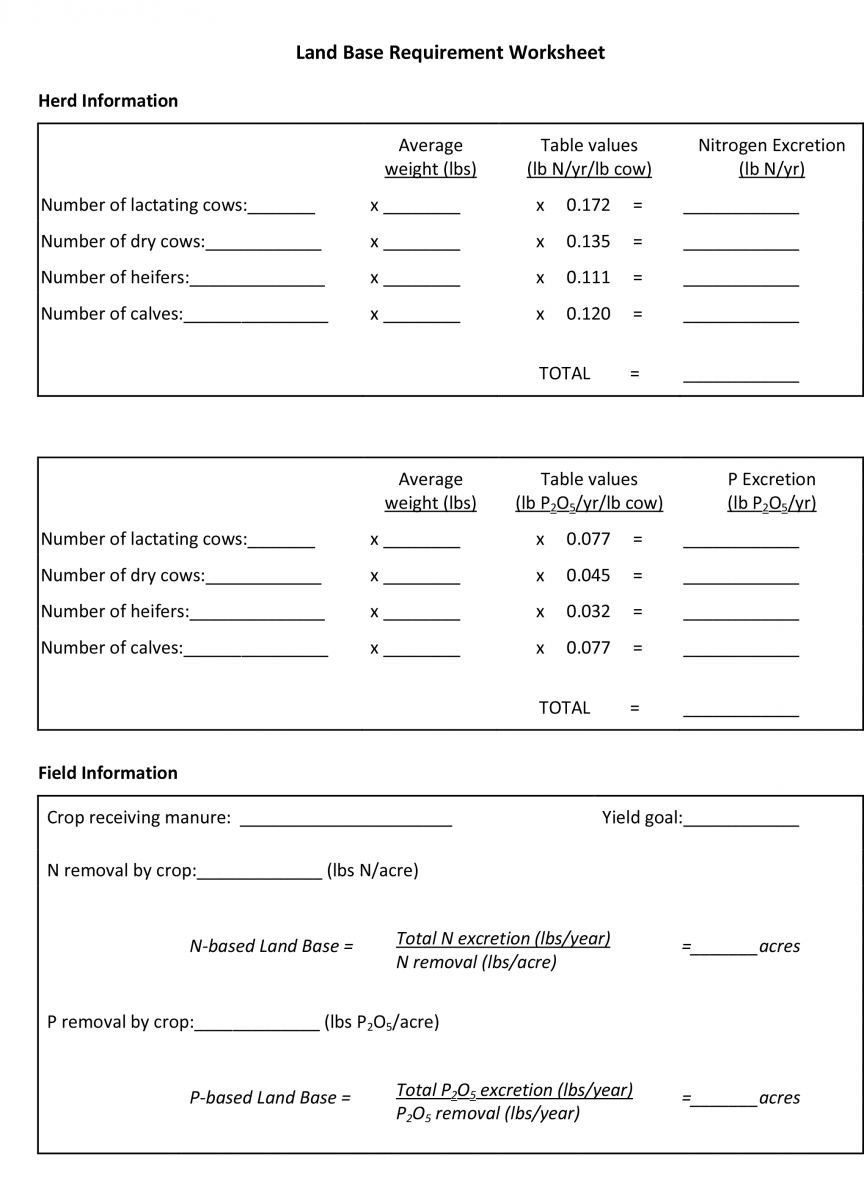Calculating Land Base Requirements for Manure Application
Introduction
Animal manure should be considered an economical source of crop nutrients. However, applying excess nutrients to a crop field wastes valuable nutrients resulting in possible crop damage suppressing yield and can be harmful to the environment by contaminating surface or ground water. One crucial step in manure management is to understand the capacities of each parcel of land in which manure will be applied for optimal manure utilization. When planning a new operation or expanding an existing operation, enough land area for manure application must be included in the plan.
The factors which most often limit the amount of manure that can be applied to a cropland are the existing soil fertility levels, manure nutrient content, crop nutrient needs, site limitations, slope, runoff potential, and leaching potential. These factors will ensure that enough land area is available in future years to prevent nutrient buildup in the soil beyond suggested agronomic and environmental levels. Nitrogen and phosphorus are usually the limiting nutrients for manure application. All manure contains measurable amounts of both. Applying levels that exceed crop nutrient requirements may lead to nutrients entering surface waters or leaching into ground water. Certain practices including manure incorporation into soil and intensive control of runoff at the application site can minimize environmental impacts from manure application.
If the land base is determined to be inadequate, arrangements must be made to reduce manure production (reduce herd size) or find alternative outlets for manure. Neighbors may own land with poor soils; manure could improve the productivity of these soils. There may also be opportunities to compost manure and sell it to area gardeners and landscapers.
Required information
In order to calculate the required minimum land base, producers will need the following information:
- Number of lactating cows, dry cows, heifers, and calves.
- Average weight of animals.
- Crop type which receives most of the manure.
- N removal by the crop (lbs/acre).
- P2O5 removal by the crop (lbs/acre).
Enter the above values into the following worksheet to find out if sufficient land is available for the amount of manure that is currently generate at your farm.

Nutrient Removal by Crops Commonly Grown by Dairy Producers in Massachusetts
| Crop | LB N | lb p2O5 | ||
|---|---|---|---|---|
| Alfalfa Hay | 5.6 | per ton | 15 | per ton |
| Alfalfa Haylage | 4.5 | per ton | 10 | per ton |
| Grass Hay | 4.0 | per ton | 13 | per ton |
| Corn Silage (35% dry matter) | 2.2 | per ton | 5 | per ton |
| Corn Grain | 0.9 | per bushel | 0.4 | per bushel |
Note The factors which most often limit the amount of manure that can be applied to a cropland are:
- existing soil fertility levels
- manure nutrient content
- crop nutrient needs
- site limitations, slope
- runoff potential
- leaching potential
Resources
Davis, J., R. Koenig, and R. Flynn. 2010. Manure Best Management Practices: A Practical Guide for Dairies in Colorado, Utah, and New Mexico. Colorado, Utah, and New Mexico Cooperative Extension Service http://extension.usu.edu/files/publications/publication/AG_WM-04.pdf.
Johnson, J., and D. Eckert. Land Based Application of Animal Manure. AGF.208-95. Ohio State University Cooperative Extension Service. http://ohioline.osu.edu/factsheet/ANR-21
Lander, C., D. Moffitt, and K. Alt. 1998. Nutrients Available from Livestock Manure Relative to Crop Growth Requirements. Natural Resource Conservation Service. https://www.nrcs.usda.gov/wps/portal/nrcs/detail/national/technical/nra/dma/?cid=nrcs143_014175
For more information visit the UMass Extension Crops, Dairy, Livestock & Equine Program
Factsheets in this series were prepared by, Masoud Hashemi, Stephen Herbert, Carrie Chickering-Sears, Sarah Weis, Carlos Gradil, Steve Purdy, Mark Huyler, and Randy Prostak, in collaboration with Jacqui Carlevale.
This publication has been funded in part by the Massachusetts Department of Agricultural Resources and the Massachusetts Farm Bureau Federation, Inc.